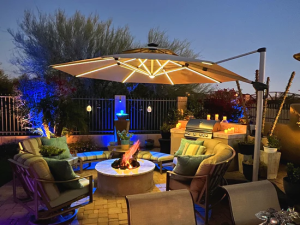More
Exploring the Backbone: Understanding the Types of Frames for Outdoor Umbrellas
Exploring the Backbone: Understanding the Types of Frames for Outdoor Umbrellas
Introduction:
Outdoor umbrellas are essential for providing shade and protection from the elements in our outdoor spaces. While we often focus on the fabric and design of umbrellas, it’s important not to overlook the backbone of these structures—the umbrella frame. The frame provides the necessary support, stability, and functionality for the umbrella. In this blog post, we will explore the different types of frames commonly used in outdoor umbrellas, helping you make an informed decision when selecting the perfect umbrella for your needs.
-
Aluminum Frames: Aluminum frames are a popular choice for outdoor umbrellas due to their lightweight nature, durability, and resistance to rust and corrosion. They offer excellent strength-to-weight ratio, making them easy to maneuver and set up. Aluminum frames are ideal for various outdoor settings, from patio and poolside areas to beach destinations. Look for umbrellas with sturdy aluminum frames that are reinforced at stress points to ensure long-lasting performance.
-
Steel Frames: Steel frames provide exceptional strength and durability, making them suitable for larger and heavier umbrellas. These frames offer excellent stability, even in windy conditions. However, it’s important to note that steel frames are typically heavier than their aluminum counterparts, which can make them less portable. To prevent rusting, look for steel frames that are powder-coated or treated with a protective layer. Steel frames are often favored for commercial use, such as in restaurants, cafes, or resorts.
-
Fiberglass Frames: Fiberglass frames are known for their flexibility, strength, and resistance to rust and corrosion. These frames are lightweight yet sturdy, making them an excellent choice for windy areas. Fiberglass has a natural flex that allows the umbrella to bend and absorb wind gusts without breaking. Umbrellas with fiberglass frames are also less prone to denting or warping. Additionally, fiberglass frames offer better resistance to saltwater, making them suitable for coastal regions.
-
Wood Frames: For a classic and timeless look, wood frames are an attractive option. Wood frames, typically made from hardwoods like teak or eucalyptus, add a touch of natural beauty to outdoor spaces. However, it’s important to note that wood frames require regular maintenance to protect against rot, insects, and weather damage. Wood frames may be heavier and less portable than metal frames, but their aesthetic appeal and durability make them a popular choice for upscale outdoor settings.
-
Cantilever Frames: Cantilever or offset umbrellas feature a unique frame design where the canopy is supported by an adjustable side post, allowing for versatile shade placement without a center pole. These frames can be made from aluminum, steel, or fiberglass, depending on the manufacturer. Cantilever umbrellas are perfect for creating unobstructed shade over outdoor seating areas or poolside lounges. Look for cantilever umbrellas with sturdy and adjustable frames to ensure maximum versatility and functionality.


Conclusion:
When selecting an outdoor umbrella, it’s essential to consider the type of frame used, as it determines the umbrella’s durability, stability, and overall functionality. Aluminum frames provide a lightweight and rust-resistant option, while steel frames offer robust stability. Fiberglass frames offer flexibility and strength, ideal for windy conditions, while wood frames provide a classic and natural aesthetic. Cantilever frames offer versatile shade placement without a center pole. Consider your specific needs, style preferences, and the environmental conditions in your area when choosing the frame type for your outdoor umbrella. With the right frame, your umbrella will stand tall, providing you with years of shade, comfort, and enjoyment in your outdoor oasis.











